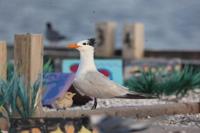WORCESTER CO., Md. - A tern raft floating in the Chincoteague Bay in Worcester County is celebrating its fifth successful year of providing a safe nesting site for hundreds of endangered waterbirds.
Maryland’s Department of Natural Resources, along with the Maryland Coastal Bays Program and Audubon Mid-Atlantic first built a 32-foot-by-32-foot artificial island in 2021 to replicate diminished nesting habitat for multiple species of terns. According to DNR, many of the small islands that had hosted the birds had been washed away in Maryland’s coastal bays, further threatening tern populations.
DNR says the populations of the waterbirds in Maryland had seen a decline by as much as 95% since the 1980s due to habitat loss.
Now, the tern raft, expanded to 48 feet by 48 feet and complete with crushed surf clam shells and artificial grass to mimic sandy beaches, has hosted more than 1,100 common tern nests since its construction. DNR says it has become the most productive breeding site for terns in Maryland.
In its fifth year, the raft saw more than 350 tern chicks fledge, according to officials. DNR says the raft also hosted nesting royal terns for the first time in 2025, with eight chicks fledged from 29 nests.
“Over five years this has become a big success—it’s producing equal to and in many cases higher than natural colonies,” Dave Brinker, a DNR Wildlife and Heritage Service avian conservation ecologist who helps to lead the tern raft project. “There’s more work to do, but in Worcester County, we’ve turned around a massive decline.”
Officials say the terns are showing close to an 80% return rate to the raft, indicating the waterbirds have become quite fond of their new breeding site.
Each year, terns migrate vast distances to breed in the summer in the Caribbean, United States, and Canada before travelling to Central and South America for the winter. While visiting Maryland’s Eastern Shore, biologists with DNR and the Coastal Bays Program band the birds to track their numbers and their travels.
With the tern raft’s success, biologists are now turning their attention to restore nearby beaches to encourage more terns to nest in the area.
“An important part of the raft is maintaining a breeding population in Maryland so when we can take these next steps and improve habitat, the birds are local and they can just move next door,” Brinker said. “If we hadn’t put the raft in, I think it would be a much bigger struggle to get founding birds to occupy this newly restored habitat.”
While the birds that visited the raft this year are off to their winter destinations, DNR says many will likely be back in the spring to rejoin the busy raft colony and continue their rebound in Maryland.



